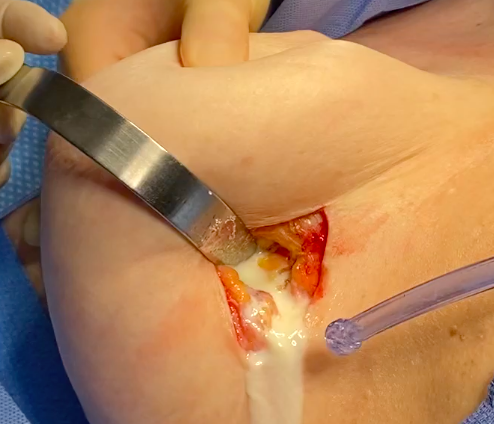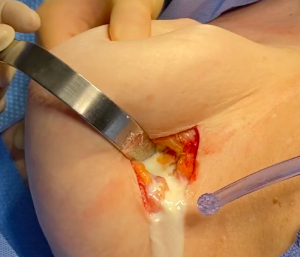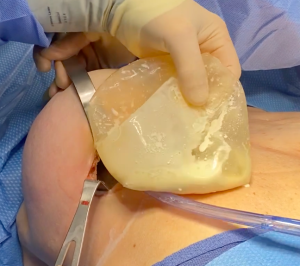Background: Saline-filled implants have been an available device used in breast augmentation for decades. They reached their highest use in the years between 1991 and 2006 when silicone breast implants were not available. But they still remain a useful breast augmentation device for those patients who are opposed to a silicone-filled device or those seeking larger breast augmented sizes.
In much larger or more ‘extreme’ breast augmentation goals, overfilled saline implants must be used in the U.S. While the largest saline implant size is 800ccs, manufacturer recommended maximum fill size is 960ccs. (maximum fill size of any saline implant is always 20% over its base size) But in reality much more saline volume can be safely added and it is not rare for inflation sizes to go between 1,000 and 1,500ccs (or even greater) based on the patient’s augmentation goals. Whether such volumes have any impact on the long-term integrity of the implant shell is not known.
But regardless of whatever volume is in a saline breast implant the patient must be prepared for the day when the inevitable device failure will occur. It is never a question of if but when. Eventually the implant shell will develop an opening (tear or fold flaw) and the saline fill will come out. Sometimes this can be a dramatic immediate breast deflation or in others it may be a more gradual loss of visible breast size. It all depends on where the hole in the implant shell occurs, the size of the breast implant and how much natural breast tissue the patient has.
While the bad news is that saline breast implant failure is inevitable, and you usually don’t replace the implants until it occurs, the goods news is that replacement implants can be quickly inserted. This is usually a much easier surgery and recovery than the original surgery. The deflated implants are straightforward to remove, any residual saline in the pocket is harmless and easily suctioned away and new implants (saline or silicone) placed. Unlike silicone get implants, there is no residual silicone gel to extract and removing the surrounding capsules is not necessary as they neither contain silicone gel or are calcified. Having larger breast implant sizes does to make this remove and replacement process any harder to do.
This is the usual scenario with remove and replace saline breast implants until…
Case Study: This older female had a history of large saline breast implants placed over twenty years ago. They were 800cc implants filled to 960ccs. She also had a breast lift done at the same time. They were perfectly fine until both implants underwent a very visible loss in size recently. First the left went down and then the right. Besides the deflated breasts there was very visible folds in the skin on the inner pole of the breast near the sternum. (which normally would be consistent with the expected folds of a deflated implant. She desired saline implant replacements filled to at least 1,200ccs.




Saline breast implants are well known to develop capsular calcifications but they are usually far less than that observed in silicone breast implants. Most of the capsular calcifications have been reported as more microscopic in nature as opposed to silicone implants. The calcium appears as agglomerates, has a crystalline appearance and has both calcium and phosphorous elements present. While the capsular calcifications may be explained by prior history with all breast implants the white liquid present in the partially deflated implant can not. The white liquid is clearly calcium of some form in solution but how does it get inside the implant shell? Is the liquid a precipitation of calcium that has passed through the shell and interacted with the chloride in the saline solution and created a calcium chloride suspension?? Did the intense calcified hard capsules present such a calcium load up against the implant that some calcium ions passed through the shell to create an intraimplant precipitate? If so, how does calcium pass through the implant shell but a saline solution can not??
Calcium is an interesting element being #20 on the Periodic table and being part of Group 2. While not often perceived as a metal element it is an alkaline earth metal that is highly reactive with non metals such as chlorine. What causes calcium to leach out of circulation and deposit into and on the surface of a breast implant capsule, which is not a rare occurrence, has never been completely explained. Some breast implant patients have it and others may not.
This patient represents a biologic reaction to her saline breast implants that awaits a better explanation than I have. Interestingly, despite theirather dramatic appearance of the liquid and capsules she was asymptomatic with no pain or any findings seen in many breast implant illness (BII) patients.
Case Highlights:
1) Saline breast implants are well known and expected to eventually fail (deflate) and are not lifelong devices.
2) The association of a white-colored liquid in the deflated saline breast implants combined with intensely calcified capsules is a novel phenomenon in which an exact biologic explanation can only be speculated.
3) Larger saline breast implant replacements is going to require a total capsulectomy particularly when it is heavily calcified.
Dr. Barry Eppley
Indianapolis, Indiana








